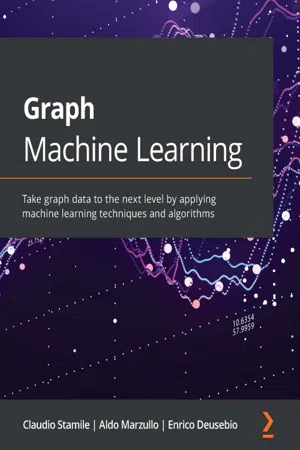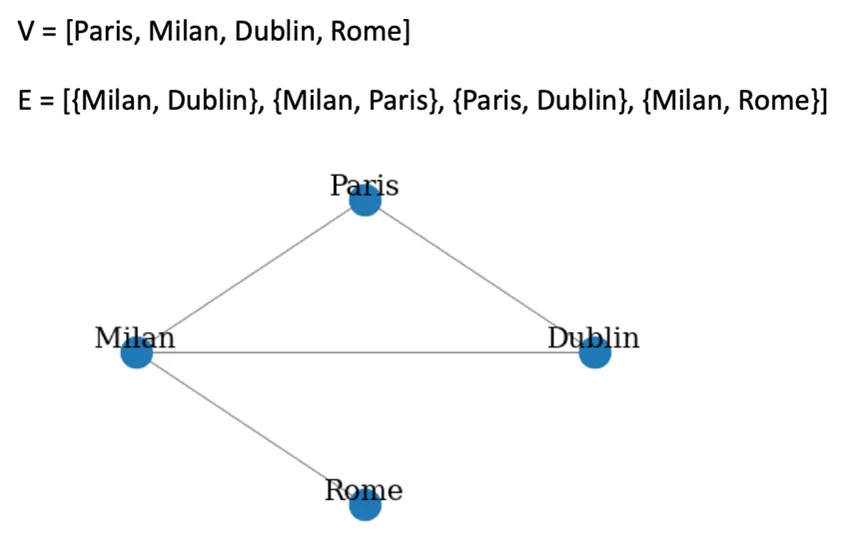
- 338 pages
- English
- ePUB (mobile friendly)
- Available on iOS & Android
Graph Machine Learning
About this book
Build machine learning algorithms using graph data and efficiently exploit topological information within your modelsKey Features• Implement machine learning techniques and algorithms in graph data• Identify the relationship between nodes in order to make better business decisions• Apply graph-based machine learning methods to solve real-life problemsBook DescriptionGraph Machine Learning will introduce you to a set of tools used for processing network data and leveraging the power of the relation between entities that can be used for predictive, modeling, and analytics tasks. The first chapters will introduce you to graph theory and graph machine learning, as well as the scope of their potential use. You'll then learn all you need to know about the main machine learning models for graph representation learning: their purpose, how they work, and how they can be implemented in a wide range of supervised and unsupervised learning applications. You'll build a complete machine learning pipeline, including data processing, model training, and prediction in order to exploit the full potential of graph data. After covering the basics, you'll be taken through real-world scenarios such as extracting data from social networks, text analytics, and natural language processing (NLP) using graphs and financial transaction systems on graphs. You'll also learn how to build and scale out data-driven applications for graph analytics to store, query, and process network information, and explore the latest trends on graphs. By the end of this machine learning book, you will have learned essential concepts of graph theory and all the algorithms and techniques used to build successful machine learning applications.What you will learn• Write Python scripts to extract features from graphs• Distinguish between the main graph representation learning techniques• Learn how to extract data from social networks, financial transaction systems, for text analysis, and more• Implement the main unsupervised and supervised graph embedding techniques• Get to grips with shallow embedding methods, graph neural networks, graph regularization methods, and more• Deploy and scale out your application seamlesslyWho this book is forThis book is for data scientists, data analysts, graph analysts, and graph professionals who want to leverage the information embedded in the connections and relations between data points to boost their analysis and model performance using machine learning. It will also be useful for machine learning developers or anyone who wants to build ML-driven graph databases. A beginner-level understanding of graph databases and graph data is required, alongside a solid understanding of ML basics. You'll also need intermediate-level Python programming knowledge to get started with this book.
Frequently asked questions
- Essential is ideal for learners and professionals who enjoy exploring a wide range of subjects. Access the Essential Library with 800,000+ trusted titles and best-sellers across business, personal growth, and the humanities. Includes unlimited reading time and Standard Read Aloud voice.
- Complete: Perfect for advanced learners and researchers needing full, unrestricted access. Unlock 1.4M+ books across hundreds of subjects, including academic and specialized titles. The Complete Plan also includes advanced features like Premium Read Aloud and Research Assistant.
Please note we cannot support devices running on iOS 13 and Android 7 or earlier. Learn more about using the app.
Information
Section 1 – Introduction to Graph Machine Learning
- Chapter 1, Getting Started with Graphs
- Chapter 2, Graph Machine Learning
Chapter 1: Getting Started with Graphs
- Introduction to graphs with networkx
- Plotting graphs
- Graph properties
- Benchmarks and repositories
- Dealing with large graphs
Technical requirements
- import networkx as nx
- import pandas as pd
- import numpy as np
Introduction to graphs with networkx










- The order of a graph is the number of its vertices |V|. The size of a graph is the number of its edges |E|.
- The degree of a vertex is the number of edges that are adjacent to it. The neighbors of a vertex v in a graph G is a subset of vertex induced by all vertices adjacent to v.

- The neighborhood graph (also known as an ego graph) of a vertex v in a graph G is a subgraph of G, composed of the vertices adjacent to v and all edges connecting vertices adjacent to v.

Table of contents
- Graph Machine Learning
- Contributors
- Preface
- Section 1 – Introduction to Graph Machine Learning
- Chapter 1: Getting Started with Graphs
- Chapter 2: Graph Machine Learning
- Section 2 – Machine Learning on Graphs
- Chapter 3: Unsupervised Graph Learning
- Chapter 4: Supervised Graph Learning
- Chapter 5: Problems with Machine Learning on Graphs
- Section 3 – Advanced Applications of Graph Machine Learning
- Chapter 6: Social Network Graphs
- Chapter 7: Text Analytics and Natural Language Processing Using Graphs
- Chapter 8:Graph Analysis for Credit Card Transactions
- Chapter 9: Building a Data-Driven Graph-Powered Application
- Chapter 10: Novel Trends on Graphs
- Other Books You May Enjoy